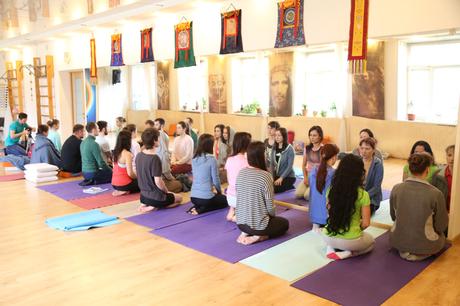Yoga is one of the greatest gifts from the consciousness to humans to connect to our divine nature. Each culture responds to the environment they inhabit. Different survival strategies develop, when the group goes beyond mere survival and start focusing on spiritual development, then a rich culture is developed. Just like specific animals and plants adapt and thrive in certain conditions, so did the spiritual seekers thrive in India’s fertile environment. Its culture, land, and climate were receptive to this incredible knowledge of Yoga to benefit the humanity. There were thousands of known, unknown Yogi’s, seers, mystics and enlightened masters who experienced liberation. The real beauty lies in the fact that these enlightened ones, such as Patanjali, shared their wisdom and being with the populace to direct us on our spiritual journey.
There was no exact record in the history when Yoga started, but there are many ancient archeological sites showing signs of Yogic activity. Harappa and Mohenjodaro now in Pakistan are ancient cities with remnant statues of yogis in yoga poses. Ancient scriptures that refer to yogic practices are the Upanishad’s by unknown Rishi’s (seers), and Shivsutra from Lord Shiva and the Bhagwadgita by Sri Krishna.

In the Yoga tradition, Yogi’s shared their philosophy, wisdom and practice in the oral tradition of Sanskrit, an ancient language of India. This is why mantras and Vedas are traditionally chanted, rather than written down. In this course, you will learn essential terms and names and translations from Sanskrit. Traditionally Yoga was meant only for Sadhu’s (monks), who renounce everything including family to attain the libration through spiritual practice. The strict and arduous initiation (sannyas) process was done by living with the master in humble devotion that underpinned all the yogic practices and methods. The sannyasi surrendered unconditionally to learn and practice under the guidance of the master. One never knew when the disciple would attain liberation, but practicing with patience and surrendered was essential to be with the Master.
As the population expanded, a higher number of householders with families and responsibilities had a thirst for spiritual practices, yet were unable to renounce the world. Some compassionate masters started making it available to the householders as well. The Yogic path leads one ultimately to attain liberation from this world, but along the way, it benefits our physical, mental and emotional health immensely. In the modern world, Yoga is geared more towards holistic health purpose, managing stress in our lives, enjoying and maintaining good health.

The importance of the teacher in learning Yoga
The teacher has learned compassion and bravery along the path that is riddled with obstacles. The spiritual way is not like a highway, and there are many turns, twist going backward and forward, anguish and joy. Giving up the mind or transcending the mind is not so easy. It will struggle for its survival and can give you good fight by diverting your energy and willpower in weak moments. Our intention is surviving on our strength and manipulating and living through us through many lives. When you climb a mountain, and the path is very steep and narrow you need a guide who can make you aware of the journey’s dangers and who is willing to hold a space when the student is in need. You cannot hire the guide to climb the mountain to reach the top (Samadhi). You have to surrender one’s ego to make progress on the path. The teacher is there to challenge and guide the student on the actions they take and practice.
—
Author is Yoga Teacher at Yoga Teacher Training School – Bali

